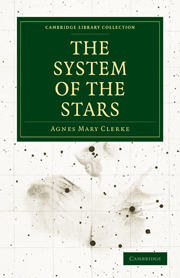Book contents
- Frontmatter
- PREFACE
- Contents
- ILLUSTRATIONS
- ADDENDA
- CHAPTER I THE TASK OF SIDEREAL ASTRONOMY
- CHAPTER II THE METHODS OF SIDEREAL RESEARCH
- CHAPTER III SIRIAN AND SOLAR STARS
- CHAPTER IV STARS WITH BANDED SPECTRA
- CHAPTER V GASEOUS STARS AND NEBULÆ
- CHAPTER VI SIDEREAL EVOLUTION
- CHAPTER VII TEMPORARY STARS
- CHAPTER VIII VARIABLE STARS OF LONG PERIOD
- CHAPTER IX VARIABLE STARS OF SHORT PERIOD
- CHAPTER X THE COLOURS OF THE STARS
- CHAPTER XI DOUBLE STARS
- CHAPTER XII VARIABLE DOUBLE STARS
- CHAPTER XIII STELLAR ORBITS
- CHAPTER XIV MULTIPLE STARS
- CHAPTER XV THE PLEIADES
- CHAPTER XVI STAR CLUSTERS
- CHAPTER XVII THE FORMS OF NEBULÆ
- CHAPTER XVIII THE GREAT NEBULÆ
- CHAPTER XIX THE NATURE AND CHANGES OF NEBULÆ
- CHAPTER XX THE DISTANCES OF THE STARS
- CHAPTER XXI TRANSLATION OF THE SOLAR SYSTEM
- CHAPTER XXII THE PROPER MOTIONS OF THE STARS
- CHAPTER XXIII THE MILKY WAY
- CHAPTER XXIV STATUS OF THE NEBULÆ
- CHAPTER XXV THE CONSTRUCTION OF THE HEAVENS
- APPENDIX.—TABLES OF STELLAR DATA
- INDEX
- Plate section
CHAPTER XII - VARIABLE DOUBLE STARS
Published online by Cambridge University Press: 05 July 2011
- Frontmatter
- PREFACE
- Contents
- ILLUSTRATIONS
- ADDENDA
- CHAPTER I THE TASK OF SIDEREAL ASTRONOMY
- CHAPTER II THE METHODS OF SIDEREAL RESEARCH
- CHAPTER III SIRIAN AND SOLAR STARS
- CHAPTER IV STARS WITH BANDED SPECTRA
- CHAPTER V GASEOUS STARS AND NEBULÆ
- CHAPTER VI SIDEREAL EVOLUTION
- CHAPTER VII TEMPORARY STARS
- CHAPTER VIII VARIABLE STARS OF LONG PERIOD
- CHAPTER IX VARIABLE STARS OF SHORT PERIOD
- CHAPTER X THE COLOURS OF THE STARS
- CHAPTER XI DOUBLE STARS
- CHAPTER XII VARIABLE DOUBLE STARS
- CHAPTER XIII STELLAR ORBITS
- CHAPTER XIV MULTIPLE STARS
- CHAPTER XV THE PLEIADES
- CHAPTER XVI STAR CLUSTERS
- CHAPTER XVII THE FORMS OF NEBULÆ
- CHAPTER XVIII THE GREAT NEBULÆ
- CHAPTER XIX THE NATURE AND CHANGES OF NEBULÆ
- CHAPTER XX THE DISTANCES OF THE STARS
- CHAPTER XXI TRANSLATION OF THE SOLAR SYSTEM
- CHAPTER XXII THE PROPER MOTIONS OF THE STARS
- CHAPTER XXIII THE MILKY WAY
- CHAPTER XXIV STATUS OF THE NEBULÆ
- CHAPTER XXV THE CONSTRUCTION OF THE HEAVENS
- APPENDIX.—TABLES OF STELLAR DATA
- INDEX
- Plate section
Summary
The light-changes of double stars are commonly of a fitful and indecisive kind. They may affect one or both members of stationary pairs; but visibly revolving stars, as a rule, conspire to vary, if they vary at all. The alternating fluctuations of γ Virginis, discoverable only by close attention to the swaying balance of lustre between the components, are in this respect typical. Each may be described as normally of the third magnitude, and each in turn declines by about half a magnitude and recovers within a few days, yet so that the general preponderance during a cycle of several years, remains to the same star. The existence of this double periodicity was recognised in 1851 by M. Otto Struve, who, however, despaired of investigating it with success in a latitude where the stars in question never rise more than 30° above the horizon.
Their circulation is in the most eccentric of ascertained stellar orbits (see fig. 30). The ellipse traversed by γ Virginis in 180 years is, in fact, proportionately somewhat narrower than the path round the sun of Encke's comet, so that the stars will in 1926 be separated by fully seventeen times the interval of space between them in 1836, when they merged into a single telescopic object. Their inequalities of light seem to have developed as they approached each other; at least, they first began to be noticed by Struve in 1818, and they at present tend to become obliterated, whether to revive with regained proximity towards the close of the twentieth century, future observations must decide.
- Type
- Chapter
- Information
- The System of the Stars , pp. 179 - 186Publisher: Cambridge University PressPrint publication year: 2010First published in: 1890



